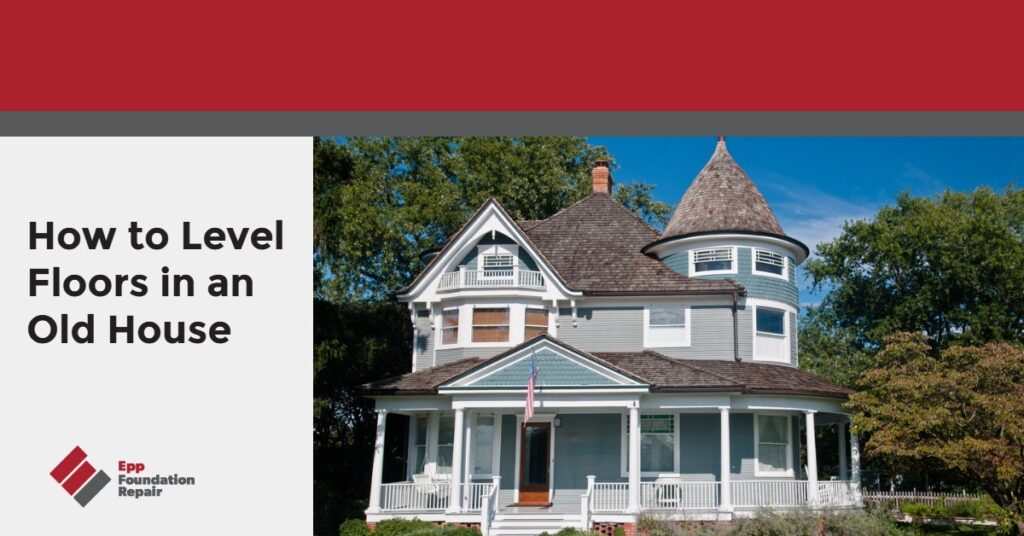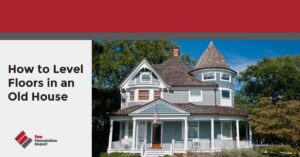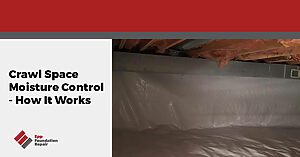If you’re looking for information on how to level floors in an old house, don’t hit that back button because you’ve landed on the right page. In this article, we’re going to talk about why floors in old houses become unlevel, common causes of foundation trouble in older homes, how to level floors in an old house, and more.
First Things First: Why Is The Floor Unlevel?
Usually, floors in older homes become unlevel due to a phenomenon called differential settlement. Differential settlement is when a structure is sinking into the ground unevenly. The below graphic illustrates the problem:
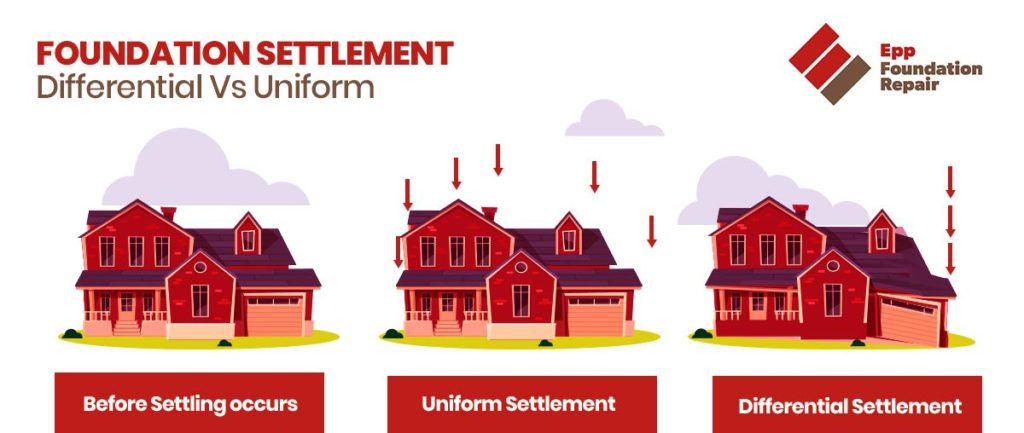
Differential settlement puts a lot of stress on the foundation. Because it puts everything out of plumb, you’ll notice problems like uneven floors, doors and windows that no longer open and close properly, wall cracks, etc.
How To Level Floors in an Old House: Solve The Root Problem
Unless you solve the root problem, it’s not worth leveling an uneven floor because the problem will return. If the floor is unlevel due to differential settlement, you’ll need to fix that problem if you want to level the floor in an old house. That means you’ll need to know why the house is experiencing differential settlement.
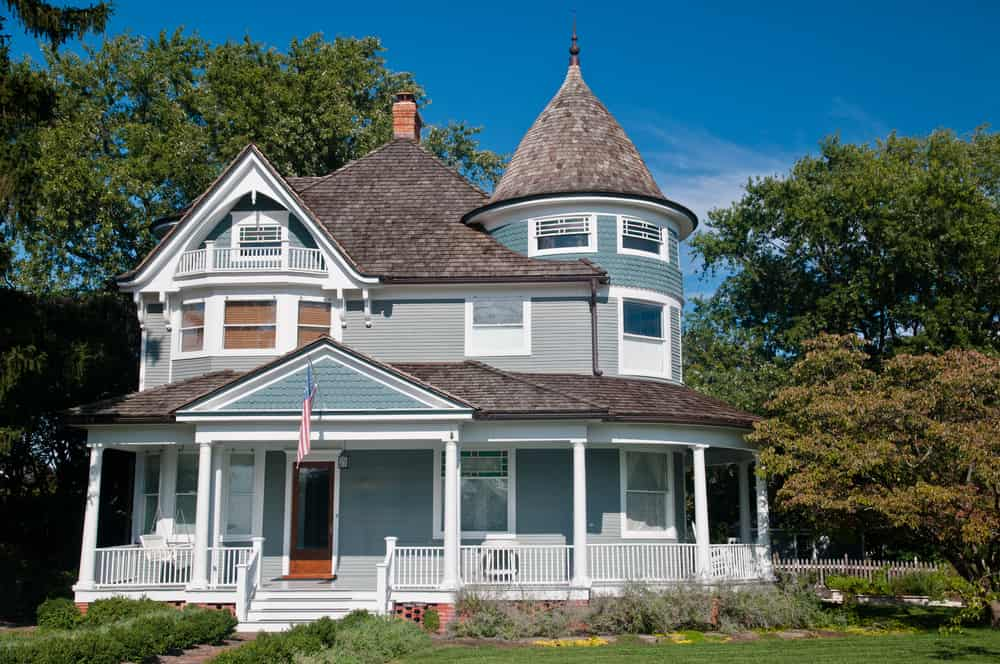
So, What Causes Differential Settlement?
Differential settlement is caused by various things, including:
- Expansive soil – This is soil that expands as it soaks up moisture and shrinks as it dries out. Over time, this will cause foundation trouble.
- Soil that wasn’t adequately prepped – Soil needs to be compacted before anything gets built on top of it. If this isn’t done correctly, the structure could experience differential settlement. Read also – What’s The Best Soil For Building A Foundation?
- Seismic activity, floods, sinkholes, etc.
- Weather changes – For example, if you build a house on top of expansive soil during the wet season, you could have problems when the dry season comes around, and the soil shrinks.
- Excavation next to the foundation – Digging too close to a foundation can cause trouble.
- Tree roots – A large, water-hungry tree too close to the foundation will “drink” moisture out of the soil and cause voids to form under the foundation. When the house sinks into the voids, you have differential settlement. Read more – Can Tree Roots Damage A Foundation?
Fixing damage to a foundation caused by differential settlement is not a DIY project. If you have an older house with unlevel floors, the problem is likely differential settlement. That means you’ll need to have the home inspected by an experienced foundation repair contractor or a structural engineer. They will be able to tell you what’s going on, and a foundation repair contractor will also be able to give you a repair estimate.
Other Causes of Foundation Problems in Old Houses
Water is the leading cause of foundation problems in old houses with a basement or crawl space foundation. Here’s how it frequently happens…
When there’s poor drainage in the soil around the foundation, the excess water will cause hydrostatic pressure to build up and start pushing against the foundation walls. Hydrostatic pressure exerts a lot of force against foundation walls and can even cause them to bow inward and crack. Hydrostatic pressure can also push water into the basement or crawl space via small cracks you didn’t even know were there. This problem is not unique to older homes. However, older homes are more likely to have drainage problems.
The best way to prevent foundation problems caused by hydrostatic pressure is to control groundwater around the foundation. For more information on how to do this, see The Importance Of Proper Foundation Drainage Around Your Home.
How To Level Floors in an Old House: A Job for the Pros
An unlevel floor in an old house is probably just one problem among many. If the home is experiencing differential settlement, it will need underpinning to lift and level the foundation. This is a job for a team of experienced foundation repair professionals.
If you have an unlevel floor in an old house, look around for other signs of foundation problems. We’ll go over these in the next section. Of course, you’ll need to find out why the floor is unlevel. For that, you’ll need an inspection from either a foundation repair contractor or a structural engineer.
How Much Does it Cost to Level Floors in an Old House?
The cost to level floors in an old house depends on various factors, including:
- What’s causing the unlevel floors
- The chosen repair solution
- Your geographical location
Without inspecting the house, we can’t say how much the repair will cost. Yes, foundation repair can be expensive. However, if you wait, the problem will worsen, and you’ll pay even more money to fix the damage.
Common Signs of Foundation Problems
The following are the most common signs of foundation trouble in both older and newer homes:
- Windows and doors that don’t open and close properly – If it’s just one window or door, it might not be a foundation problem. However, trouble with multiple windows and doors is a sure sign of a foundation issue.
- Unlevel floors
- Cracked floors – Look for cracks that go all the way across the floor. A crack limited to one or two tiles was probably caused by something falling on the floor.
- Ceilings and floors that aren’t in contact with the walls – Even slight separations are a red flag.
- Wall cracks – Horizontal cracks are the most problematic. However, even vertical cracks should be inspected, especially a series of them close together.
- Ceiling cracks
- Bowed basement walls – Sometimes, the bowing is accompanied by cracking. This problem is caused by hydrostatic pressure.
- Torn or wrinkled wallpaper – The wall behind the wallpaper could be cracked.
- Diagonal cracks from the corners of doors and windows – If these are hairline cracks, they might be caused by the build-up of paint over the years. However, larger cracks are a sign of structural damage.
- Moldings that aren’t in contact with the ceiling or wall – Again, even a slight separation is a sign of trouble.
- Stair step cracks in brick or masonry – This is a sure sign of foundation trouble.
- Chimneys or porches that are pulling away from the rest of the house – This might be a problem with just the foundation under the chimney or porch. However, it could also be a sign there’s something wrong with the house’s foundation.
If you see any of the above – or anything else that seems suspicious – contact a foundation repair contractor or a structural engineer immediately for an inspection.
If you live in an old house with un-level floors and are in our service area in Nebraska, Iowa, Kansas, and Missouri, contact us today for an inspection and repair estimate.

